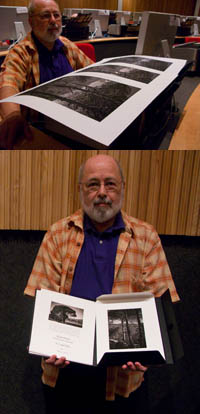
Cemal was fairly confident that he wanted an alternative process look so he printed a key image for a series of black and white images on Epson matte papers – UltraSmooth, Velvet, and Watercolor paper. He like the rich black of the Velvet surface. Then Cemal made two unexpected moves that gave what at first seemed like an antique treatment a very contemporary edge. He “crunched” his shadows running the contrast high, heavily darkened regional areas, and he used heavy sharpening (both Unsharp Mask and High Pass), making them look like photographs drifting towards etchings. He confirmed that this was indeed the most compelling treatment for his images by printing renditions with more shadow detail and less sharpening. Some experiments succeed, some fail. You need to risk failure. In fact, failures aren’t failures if you learn from them – they bring confirmation and direction. This kind of experimentation is necessary to create more distinctive and expressive prints. The key is to do focused experiments that are most likely to give useful or relevant information.
What kinds of focused experiments would help you most? List a few now!
Cemal brought with him a beautiful portfolio of small prints (printed on Moab Entrada and collected in a companion folio). Comparing them to prints of larger scale revealed yet one more facet of his work.
These are the kinds of dialogs Mac Holbert and I have every day with participants in our the Fine Art of Digital Printing workshop during our extensive One on One and Review sessions. This week we’re at the Hallmark Institute of Photography.
Find out about Cemal Ekins here.
Find out about the Hallmark Institute of Photography here.
Find out more about The Fine Art of Digital Printing workshop here.
Find out about my The Fine Digital Printing workshop series here.


No Comments